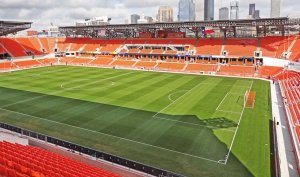Over the last two decades, Major League Soccer (MLS) has undertaken an ambitious campaign to construct soccer-specific stadiums for its clubs. These arena projects have become symbols of progress that provide fans with an enhanced experience while giving clubs state-of-the-art homes. The stadium boom has been crucial for elevating MLS' credibility and energizing local fan bases just as fast payout online casino attract players seeking instant gratification, the popularity of Major League Soccer and their stadiums continues to soar, captivating fans with its fast-paced action and thrilling matches.
Early Makeshift Homes
In MLS’ inaugural 1996 season, teams essentially played in massive American football stadiums ill-suited for soccer. While big crowds looked sparse, the cavernous venues hindered the atmosphere. Clubs like the New England Revolution, San Jose Earthquakes, and D.C. United struggled to draw crowds rattling around in oversized stadiums.
Playing on pitches marked onto turf or worn grass strained players and led to a poorer quality of play. Having tenants and off-kilter sightlines hampered revenue opportunities. The early MLS stadium situation exposed flaws in the nascent league.
Laying Foundations
In 1999, the Columbus Crew constructed the league’s first soccer-specific stadium, laying a blueprint for success. Other clubs witnessed the venue’s atmosphere and benefits, spurring a stadium boom.
The LA Galaxy opened the league’s largest soccer-specific stadium in 2003. European star David Beckham later joined the Galaxy in 2007, drawing sellout crowds to their modern new home.
Real Salt Lake entered MLS in 2005 with a compact stadium perfect for epic crowd tifos and noise. The venue set the gold standard for subsequent expansion teams.
Game Changers
Several state-of-the-art, urban MLS stadiums have opened since 2010, transforming their clubs and local soccer culture.
Sporting Kansas City moved from an ill-fitting American football stadium into a sophisticated Children’s Mercy Park in 2011. The intimate, high-tech venue offers a boisterous home-field advantage and spearheaded a team rebrand.
 Shell Energy Stadium
Shell Energy Stadium 2014 welcomed San Jose Earthquakes Avaya Stadium, providing a permanent home after sharing venues for nearly a decade. The arena helped re-energize the club and fans.
Setting New Standards
With Atlanta United’s 2017 entry into MLS, owner Arthur Blank constructed Mercedes-Benz Stadium, quickly becoming a crown-jewel venue. Its opening roof, supporter section tifos, and Atlanta record crowds signaled MLS had come of age.
LAFC took the baton in 2018 with the £350 million Banc of California Stadium. Its steep stands provide a stunning atmosphere and proximity to the pitch for a quintessential soccer sanctuary.
In 2019, FC Cincinnati joined MLS with the picturesque TQL Stadium on the banks of the Ohio River. The venue accommodates the club’s passionate fans and fueled the city’s soccer ascent.
The March Continues
MLS stadium construction continues nationwide with projects like Nashville SC’s 30,000-seat venue, set to open in 2022. New soccer palaces raise the quality of play and fan engagement.
These engineered soccer environments attract new supporters and create an impassioned home-field advantage. MLS’ expanding portfolio of world-class stadiums provides tangible indicators that soccer has taken root in America.
Lasting Impact
What began as an experiment has produced celebrated soccer cathedrals tugging on fans’ hearts. With atmospheres impossible in cavernous borrowed stadiums, MLS now offers electrifying live experiences.
Purposed venues enable clubs to control game-day logistics and revenue while tailoring facilities to their brands. Players can hone their craft on suitable pitches. Stadium energy now rivals European grounds.
Forward-thinking stadium investments will continue paying dividends by sharpening MLS’ competitiveness and connection with communities. These palaces built for soccer propel clubs into relevance and ignite fervor in generations of new fans. Brick by brick, match by match, stadium by stadium, MLS marches into the elite ranks of global soccer.
___
Sports Team History is your ultimate destination to explore the rich heritage and iconic logos of professional sports teams across MLB, MLS, NBA, NCAA, NFL, NHL, Premier League, WNBA, XFL, ABA, AAF, and USFL. Immerse yourself in the captivating tales and memorable moments that have shaped each team's legacy.
But that's not all! At Sports Team History, we believe in celebrating the exceptional talents that have graced the sports world. That's why we're thrilled to announce our upcoming "Greatest Player Poll" where fans like you can cast your votes and have your say in determining the greatest players of all time in various sports.
Our partner site, Sports Logo History, offers a vibrant community of logo enthusiasts who appreciate the evolution of team visual identities. Dive into detailed analysis and discussions surrounding logos representing the teams we love. Stay updated with Sports News History, providing 24/7 sports news coverage to keep you informed and engaged with the latest developments. Lastly, explore the premier sports team marketplace at Sports Market History, where you'll find a wide selection of jerseys, caps, and collectibles to showcase your team spirit. Embark on a journey through time, celebrate team logos, stay informed with the latest news, and discover unique sports memorabilia to enhance your collection. Let Sports Team History fuel your passion for sports.

